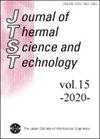Magnetothermal force effect on natural convection through a partially-heated vertical channel
IF 0.9
4区 工程技术
Q3 THERMODYNAMICS
引用次数: 1
Abstract
Natural convection of a paramagnetic fluid through a partially-heated vertical channel is numerically studied in the presence of a magnetic field from two block magnets placed behind the heated wall. Magnets are aligned with opposite orientations. This magnet orientation induces strong magnetic force normal to the magnet at the magnet junction due to short distance between poles. When the temperature-dependent magnetic susceptibility changes due to wall heating near the magnet, the magnetothermal force is induced remarkably near the magnet junction. This additional force overlaps to the natural convection along the heated wall and results in the changes of heat and fluid flow along the heated wall. It is found that, flow becomes slow and the local heat transfer is suppressed below the elevation of the magnet junction, and the flow acceleration and heat transfer enhancement are observed above the junction elevation, of which effects depend on the relative magnet elevation to the heated wall. It is also found that the transition to vibrating flow occurs at the specific magnet elevation. The timeaveraged Nusselt number suggests this vibrating convection has the potential to enhance the heat transfer remarkably because this magnetically-induced flow vibration continues along the heated wall up to the outlet.通过部分加热的垂直通道对自然对流的磁热力效应
顺磁性流体通过部分加热的垂直通道的自然对流进行了数值研究,在磁场的存在,从两个块磁铁放置在加热墙后面。磁铁以相反的方向排列。由于磁极之间的距离较短,这种磁体方向在磁体连接处诱导出向磁体垂直的强磁力。当磁体附近的壁加热导致磁化率发生变化时,磁体结附近会产生明显的磁热力。这种额外的力与沿加热壁面的自然对流重叠,导致沿加热壁面的热量和流体流动的变化。研究发现,在磁体结高程以下,流动变得缓慢,局部换热受到抑制;在磁体结高程以上,流动加速,换热增强,其影响取决于磁体对被加热壁面的相对高程。还发现,在特定的磁体高度处会发生向振动流的过渡。时间平均努塞尔数表明,这种振动对流具有显著增强传热的潜力,因为这种磁诱导的流动振动沿着加热壁面一直持续到出口。
本文章由计算机程序翻译,如有差异,请以英文原文为准。
求助全文
约1分钟内获得全文
求助全文
来源期刊
CiteScore
2.30
自引率
8.30%
发文量
0
审稿时长
5 months
期刊介绍:
JTST covers a variety of fields in thermal engineering including heat and mass transfer, thermodynamics, combustion, bio-heat transfer, micro- and macro-scale transport phenomena and practical thermal problems in industrial applications.

 求助内容:
求助内容: 应助结果提醒方式:
应助结果提醒方式:


